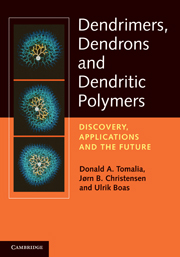Book contents
- Frontmatter
- Contents
- Foreword
- 1 Introduction
- 2 The dendritic state
- 3 Synthetic methodologies
- 4 Characterization methodologies
- 5 Nanomedical and advanced materials
- 6 Toxicology of dendrimers and dendrons
- 7 The dendritic effect
- 8 A quantized building block concept leading to a new nano-periodic system
- 9 The past, present, and future for dendrons and dendrimers
- Index
- References
7 - The dendritic effect
Published online by Cambridge University Press: 05 November 2012
- Frontmatter
- Contents
- Foreword
- 1 Introduction
- 2 The dendritic state
- 3 Synthetic methodologies
- 4 Characterization methodologies
- 5 Nanomedical and advanced materials
- 6 Toxicology of dendrimers and dendrons
- 7 The dendritic effect
- 8 A quantized building block concept leading to a new nano-periodic system
- 9 The past, present, and future for dendrons and dendrimers
- Index
- References
Summary
Introduction/definitions
The descriptor “dendritic effects” is a collective term widely used since the 1990s to describe unusual physico-chemical property patterns or trends observed for dendrons/dendrimers as a function of their generation level. These properties may be either maximized (i.e. a positive effect) or minimized (i.e. a negative effect) within a dendron/dendrimer series. A dendritic effect is referred to as either a positive or negative effect depending on whether it was accentuated or attenuated as a function of generation level. The term was generally used in an empirical sense to describe generation-dependent physico-chemical property patterns that were initially assumed to be dependent upon nanoscale sizes associated with the generation. However, accumulated evidence now reveals that these effects are dependent on more subtle parameters than mere size variations. The object of this chapter is to analyze these subtle dependences in an effort to gain insights into the cause–effect principles and predictive value of these dendritic effects. Understanding these nano-periodic property relationships should assist in dendrimer design optimization for both function and applications.
Some of the earliest dendritic effects were reported by Tomalia et al. [1–3], Astruc et al. [4] and Seebach et al. [5]. Undoubtedly, there are similar architecturally driven effects associated with the other three major polymer architectures (i.e. linear, crosslinked, and branched); however, they are generally less quantifiable due to their polydisperse structures. In any case, dendrons/dendrimers exhibit architecturally driven properties that are dramatically different to those observed for equivalent architectural isomeric types (i.e. linear, bridged (crosslinked), or branched) possessing common elemental compositions and molecular weights. In the context of a new emerging nano-periodic concept, described later in Chapter 8, dendritic effects may now be viewed as intrinsic and functional nano-periodic property patterns. In all cases they display a first-order dependency upon one of the critical nanoscale design parameters (CNDPs), namely, architecture. However, it must also be noted that dendritic effects are inextricably influenced by one or more interrelated CNDPs such as (a) size, (b) shape, (c) surface chemistry, (d) flexibility/rigidity, or (e) elemental composition, as illustrated in Figure 7.1 and 7.8. Both physical and chemical nanoscale properties are influenced by these well-defined CNDPs. This results in the manifestation of unique, intrinsic features, a few which are listed in the left and right hand columns in Figure 7.1. Many of these issues have been examined extensively elsewhere [73].
- Type
- Chapter
- Information
- Dendrimers, Dendrons, and Dendritic PolymersDiscovery, Applications, and the Future, pp. 276 - 292Publisher: Cambridge University PressPrint publication year: 2012
References
- 2
- Cited by

